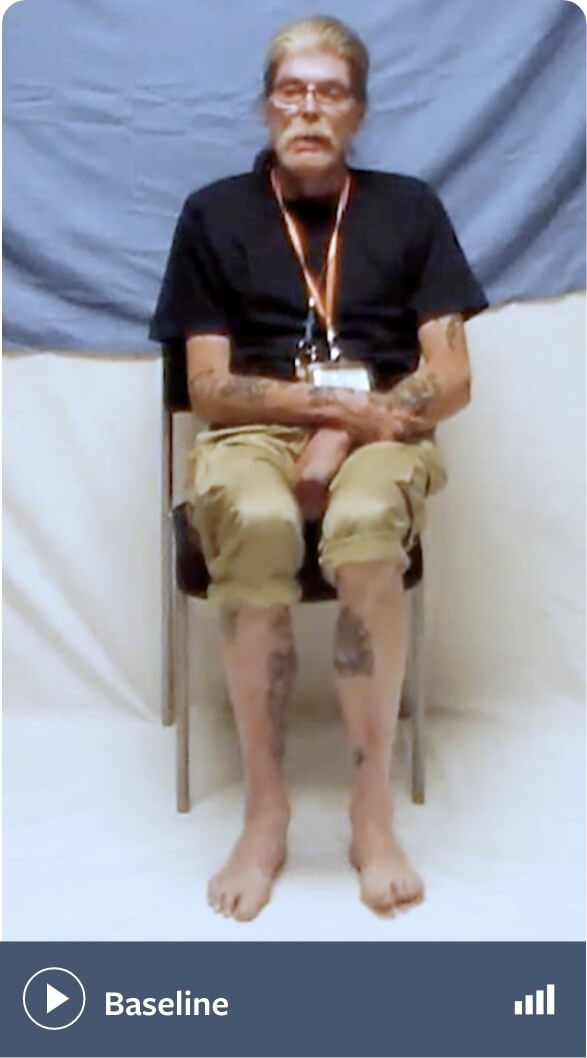INGREZZA clinical patient cases in tardive dyskinesia
See results with INGREZZA from clinical trial patients
Review tardive dyskinesia (TD) movements across a broad range of adult patients and see the effect of treatment with INGREZZA capsules.
CLINICAL TRIAL PATIENT CASES
These videos demonstrate the effect of treatment of tardive dyskinesia (TD) as seen in the INGREZZA phase 3 clinical program.
KINECT 3 pivotal triala
In KINECT 3, patients were randomized 1:1:1 to INGREZZA 40 mg, INGREZZA 80 mg, or placebo. Patients randomized to the 80 mg group received 40 mg for the first week.

Jane
Bipolar disorder





Clinical trial and treatment group:
- KINECT 3,a INGREZZA 80 mg
Relevant treatment:
- Second-generation antipsychotic to treat bipolar disorder, which resulted in TD
Relevant concomitant treatment at baseline:
- Lithium carbonate 300 mg/TID, clonazepam 2 mg/TID, citalopram 10 mg/QD, lisinopril 12.5 mg/QD
Timing of TD diagnosis:
- Approximately 5 years prior to study enrollment
Affected body regions:
- Torso (predominant), face, mouth, jaw, tongue, and limbs
Note: Not all movements may be visible in these videos
INGREZZA treatment results:
- 7-point reduction in AIMS score from baseline to Week 6; 5-point reduction from baseline to Week 48 (Baseline = 14, Week 6 = 7, Week 48 = 9)

John
Schizophrenia



Clinical trial and treatment group:
- KINECT 3,a INGREZZA 80 mg
Relevant treatment:
- Second-generation antipsychotic to treat schizophrenia, which resulted in TD
Relevant concomitant treatment at baseline:
- Risperidone IM 50 mg/QM, benztropine 2 mg/BID, citalopram 20 mg/QD
Timing of TD diagnosis:
- Approximately 30 years prior to study enrollment
Affected body regions:
- Eyebrow raising, increased blinking, lip protrusion and pursing, head nodding, and hand/finger flicking
Note: Not all movements may be visible in these videos
INGREZZA treatment results:
- 8-point reduction in AIMS score from baseline to Week 6 (Baseline = 12, Week 6 = 4)
THERAPEUTIC DOSE FROM DAY 1
The only VMAT2 inhibitor that offers an effective starting dosage you can adjust based on response and tolerability1
EXPLORE DOSINGREVIEW EFFICACY IN TD
Explore how INGREZZA reduced TD severity in both short- and long-term studies of adult patients with TD
VISIT EFFICACY IN TDKINECT 4 open-label studyb
In KINECT 4, all patients received INGREZZA 40 mg for 4 weeks. The dosage was then maintained at 40 mg or escalated to 80 mg based on patient tolerability and clinical response. This is a different dosing schedule than that in the KINECT 3 pivotal study. In KINECT 3, patients in the 80 mg group started on 40 mg and increased to 80 mg after Week 1. The impact of this on long-term effectiveness is not known.

Ed
Schizophrenia and schizoaffective disorder



Clinical trial and treatment group:
- KINECT 4,b INGREZZA 80 mg
Relevant treatment:
- Antipsychotic to treat schizophrenia, which resulted in TD
Relevant concomitant treatment at baseline:
- Haloperidol IM 50 mg/QM, lisinopril 20 mg/QD, thiamine 100 mg/QD, hydrochlorothiazide 25 mg/QD, folic acid 1 mg/QD, acetylsalicylic acid 81 mg/QD, ferrous sulfate 325 mg/QD, docusate 100 mg/BID
Timing of TD diagnosis:
- Approximately 23 years prior to study enrollment
Affected body regions:
- Upper body (predominant), all body regions
Note: Not all movements may be visible in these videos
INGREZZA treatment results:
- 8-point reduction in AIMS score from baseline to Week 8 (Baseline = 9, Week 8 = 1)

Mark
Schizophrenia and schizoaffective disorder



Clinical trial and treatment group:
- KINECT 4,b INGREZZA 80 mg
Relevant treatment:
- Antipsychotic to treat schizophrenia, which resulted in TD
Relevant concomitant treatment at baseline:
- Ziprasidone 80 mg/HS, fluoxetine 40 mg/HS, benztropine 1 mg/BID, diphenhydramine 50 mg/HS, acetylsalicylic acid 325 mg/QD, levothyroxine 75 mcg/QD, calcium 600 mg/BID, melatonin 5 mg/HS
Timing of TD diagnosis:
- Approximately 34 years prior to study enrollment
Affected body regions:
- Lips and mouth (predominant), face, upper and lower limbs, and torso
Note: Not all movements may be visible in these videos
INGREZZA treatment results:
- 1-point reduction in AIMS score from baseline to Week 8 (Baseline = 12, Week 8 = 11)

Damon
Schizophrenia and schizoaffective disorder



Clinical trial and treatment group:
- KINECT 4,b INGREZZA 80 mg
Relevant treatment:
- Second-generation antipsychotic to treat schizophrenia, which resulted in TD
Relevant concomitant treatment at baseline:
- Quetiapine 400 mg/BID, risperidone 2 mg/BID, risperidone IM 25 mg/twice monthly, benztropine 1 mg/BID, hydrochlorothiazide 25 mg/QD, montelukast 10 mg/QD, valsartan 80 mg/QD
Timing of TD diagnosis:
- Approximately 10 years prior to study enrollment
Affected body regions:
- All areas of the body regions per AIMS were affected
Note: Not all movements may be visible in these videos
INGREZZA treatment results:
- 3-point reduction in AIMS score from baseline to Week 8 (Baseline = 6, Week 8 = 3)

Chuck
Schizophrenia and schizoaffective disorder



Clinical trial and treatment group:
- KINECT 4,b INGREZZA 80 mg
Relevant treatment:
- Antipsychotic to treat schizophrenia, which resulted in TD
Relevant concomitant treatment at baseline:
- Olanzapine 7.5 mg/QD, valproate semisodium 1000 mg/QAM, clonazepam 0.5 mg/QD, lisinopril 20 mg/QD, omeprazole 20 mg/QAM, amlodipine 5 mg/QD, acetylsalicylic acid 81 mg/QD
Timing of TD diagnosis:
- Approximately 18 years prior to study enrollment
Affected body regions:
- Jaw (predominant), face, lips and perioral area, tongue, and upper and lower extremities
Note: Not all movements may be visible in these videos
INGREZZA treatment results:
- 3-point reduction in AIMS score from baseline to Week 8 (Baseline = 5, Week 8 = 2)
DOWNLOAD THE REPRINTS FOR MORE RESULTS FROM KINECT 4
| a | KINECT 3 was a phase 3, multicenter, randomized, double-blind, placebo-controlled (DBPC), parallel, fixed-dose study to evaluate the efficacy, safety, and tolerability of INGREZZA 40 mg and 80 mg, administered once daily, compared to placebo. If patients were unable to tolerate the 80 mg dose, the investigator could decrease the dose once at any time during the study. If they did not tolerate the new dose, then patients were discontinued from the study. The primary efficacy endpoint was mean change from baseline in Abnormal Involuntary Movement Scale (AIMS) dyskinesia total score at Week 6 on INGREZZA 80 mg.1,2 |
| b | KINECT 4 was a phase 3, open-label study to evaluate the safety and tolerability of INGREZZA, administered once daily for a total of 48 weeks of treatment followed by a 4-week follow-up (drug-free period). All patients received a starting dose of once-daily INGREZZA 40 mg, which could be escalated to 80 mg at the end of Week 4, based on CGI-TD score of ≥3 and acceptable safety and tolerability of 40 mg. This was a different dosing schedule than those in KINECT 3 pivotal trial. In KINECT 3, patients in the 80 mg group started on 40 mg and increased to 80 mg after Week 1. The impact of this on long-term effectiveness is not known. Videos were rated by blinded central video raters at baseline and at Week 8. Raters were blind to dose and study visit.3 |
CONNECT WITH A REPRESENTATIVE
Request an office visit from a Neurocrine representative for additional information, patient resources, or samples of INGREZZA.
REQUEST INFOREFERENCES:
- INGREZZA [package insert]. San Diego, CA: Neurocrine Biosciences, Inc.
- Hauser RA, Factor SA, Marder SR, et al. KINECT 3: a phase 3 randomized, double-blind, placebo-controlled trial of valbenazine for tardive dyskinesia. Am J Psychiatry. 2017;174(5):476-484.
- Marder SR, Singer C, Lindenmayer JP, et al. A phase 3, 1-year, open-label trial of valbenazine in adults with tardive dyskinesia. J Clin Psychopharmacol. 2019;39(6):620-627.
